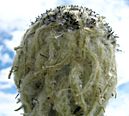Tibetan plateau
Tibet is one of the centres of high elevation
plant evolution. The climate of this world
largest high elevation plateau ranges from arid
in the west to wet in the very east. Due to the
"Massenerhebungseffekt" (a rise of isothermes in
the interior of large mountain systems), plants
reach higher elevations than anywhere else on the
globe (world records near Mt. Everest and Makalu
around 6350 m). The location presented here, a
few driving hours northeast of Lhasa, covers
alpine vegetation between 4500 and 5000 m of
elevation. Tibet has the highest species diversity
of the genera
Pedicularis (130 species),
Primula (115 species),
Saussurea (89 species)
and is home of the Edelweiss-genus
Leontopodium with 14 species.

1 -
Alpine landscape at 5000 m a.s.l.
1 -
Alpine landscape at 5000 m a.s.l.
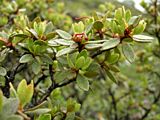
2 -
Rhododendron sp. (Ericaceae)
2 -
Rhododendron sp. (Ericaceae)
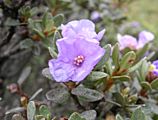
3 -
Rhododendron sp. (Ericaceae)
3 -
Rhododendron sp. (Ericaceae)

4 -
Gentiana sp. (Gentianaceae)
4 -
Gentiana sp. (Gentianaceae)
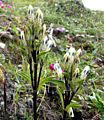
5 -
Gentiana sp. (Gentianaceae)
5 -
Gentiana sp. (Gentianaceae)
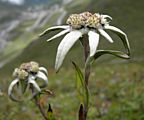
6 -
Leontopodium sp. (Asteraceae)
6 -
Leontopodium sp. (Asteraceae)
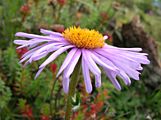
7 -
Aster sp. (Asteraceae)
7 -
Aster sp. (Asteraceae)

8 -
Pedicularis sp. (Orobanchaceae)
8 -
Pedicularis sp. (Orobanchaceae)

9 -
Delphinium sp. (Ranunculaceae)
9 -
Delphinium sp. (Ranunculaceae)
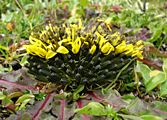
10 -
Saussurea sp. (Asteraceae)
10 -
Saussurea sp. (Asteraceae)
11 -
The bracts forming the involucrum of this
Saussurea sp. (Asteraceae)
are highly pubescent. This felt repels monsoonal moisture, reflects intense
solar radiation and creates a moderate greenhouse
effect inside the inflorescence.
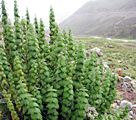
13 -
Urtica hyperborea (Urticaceae)
13 -
Urtica hyperborea (Urticaceae)











